Application of the Standard Trade Model to the American Auto Industry
VerifiedAdded on 2023/04/25
|5
|995
|232
Essay
AI Summary
This essay delves into the Standard Trade Model, examining its applicability to the American automotive industry. It highlights how the model explains international trade dynamics, including the roles of comparative advantage, relative demand and supply, and the effects of trade terms on income distribution and economic welfare. The analysis incorporates elements of the Ricardian model, the specific factors model, and the Heckscher-Ohlin model to provide a comprehensive understanding of the American automotive sector's trade outcomes, its competitive challenges, and its contribution to the overall American economy. The essay also addresses the impact of economic recessions and technological advancements on the industry's performance.
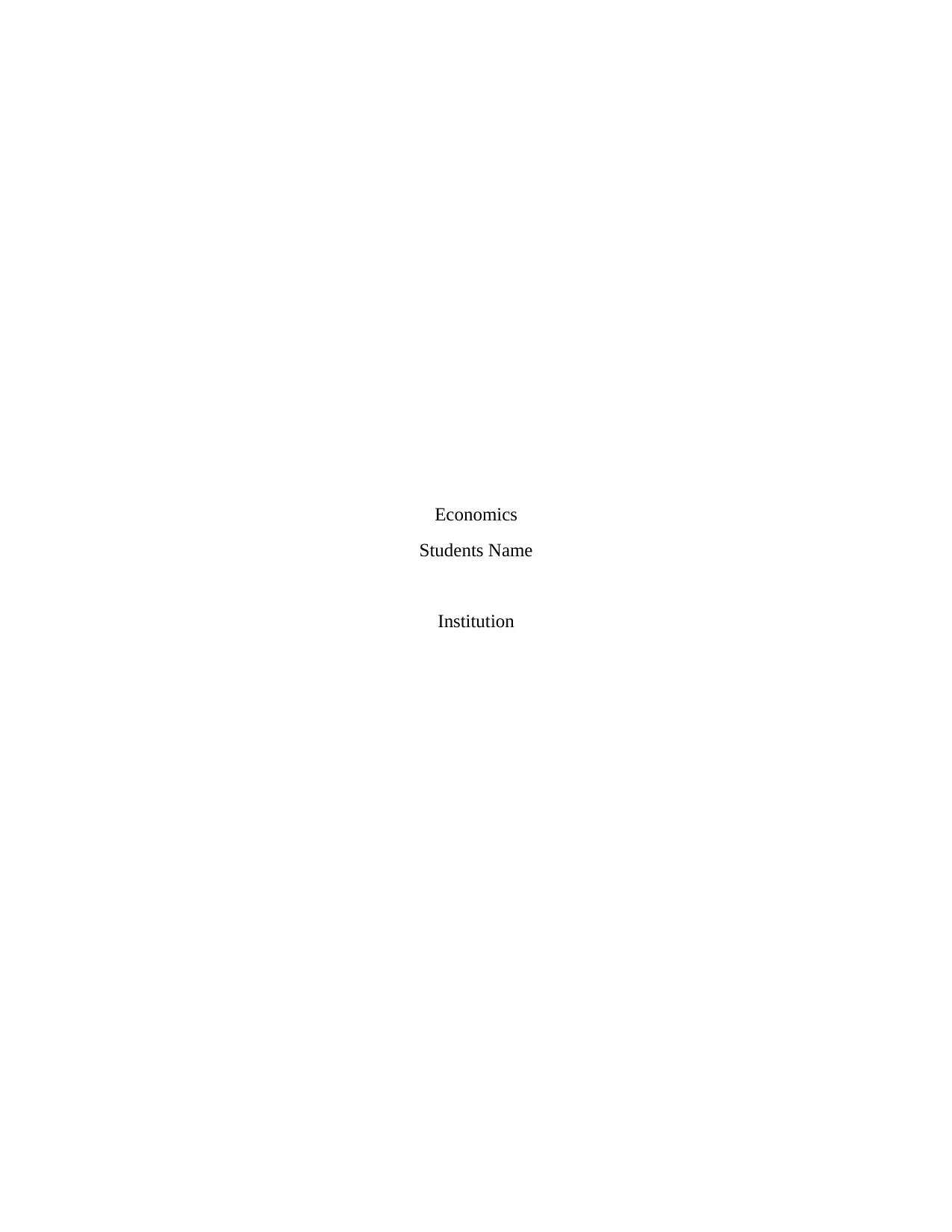
Economics
Students Name
Institution
Students Name
Institution
Paraphrase This Document
Need a fresh take? Get an instant paraphrase of this document with our AI Paraphraser
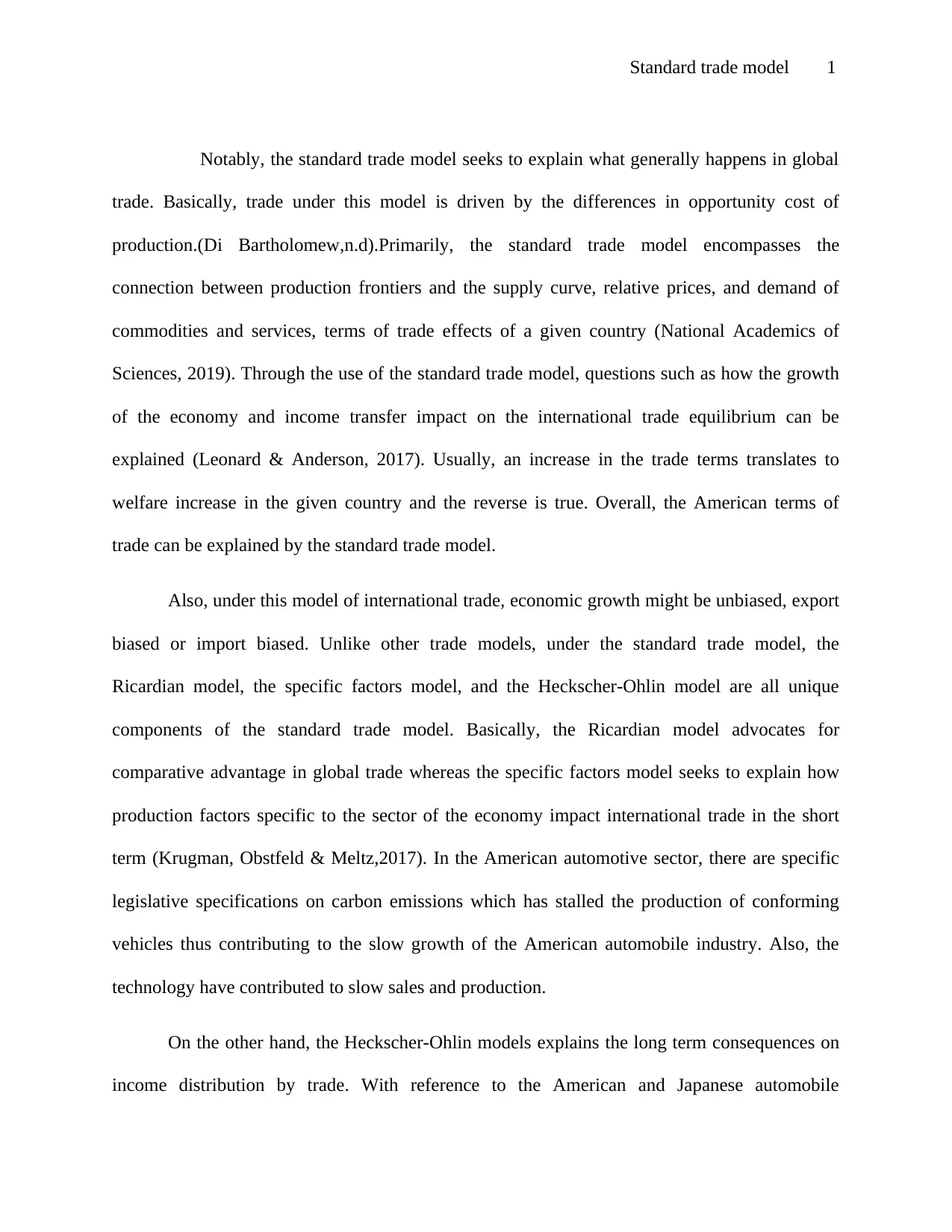
Standard trade model 1
Notably, the standard trade model seeks to explain what generally happens in global
trade. Basically, trade under this model is driven by the differences in opportunity cost of
production.(Di Bartholomew,n.d).Primarily, the standard trade model encompasses the
connection between production frontiers and the supply curve, relative prices, and demand of
commodities and services, terms of trade effects of a given country (National Academics of
Sciences, 2019). Through the use of the standard trade model, questions such as how the growth
of the economy and income transfer impact on the international trade equilibrium can be
explained (Leonard & Anderson, 2017). Usually, an increase in the trade terms translates to
welfare increase in the given country and the reverse is true. Overall, the American terms of
trade can be explained by the standard trade model.
Also, under this model of international trade, economic growth might be unbiased, export
biased or import biased. Unlike other trade models, under the standard trade model, the
Ricardian model, the specific factors model, and the Heckscher-Ohlin model are all unique
components of the standard trade model. Basically, the Ricardian model advocates for
comparative advantage in global trade whereas the specific factors model seeks to explain how
production factors specific to the sector of the economy impact international trade in the short
term (Krugman, Obstfeld & Meltz,2017). In the American automotive sector, there are specific
legislative specifications on carbon emissions which has stalled the production of conforming
vehicles thus contributing to the slow growth of the American automobile industry. Also, the
technology have contributed to slow sales and production.
On the other hand, the Heckscher-Ohlin models explains the long term consequences on
income distribution by trade. With reference to the American and Japanese automobile
Notably, the standard trade model seeks to explain what generally happens in global
trade. Basically, trade under this model is driven by the differences in opportunity cost of
production.(Di Bartholomew,n.d).Primarily, the standard trade model encompasses the
connection between production frontiers and the supply curve, relative prices, and demand of
commodities and services, terms of trade effects of a given country (National Academics of
Sciences, 2019). Through the use of the standard trade model, questions such as how the growth
of the economy and income transfer impact on the international trade equilibrium can be
explained (Leonard & Anderson, 2017). Usually, an increase in the trade terms translates to
welfare increase in the given country and the reverse is true. Overall, the American terms of
trade can be explained by the standard trade model.
Also, under this model of international trade, economic growth might be unbiased, export
biased or import biased. Unlike other trade models, under the standard trade model, the
Ricardian model, the specific factors model, and the Heckscher-Ohlin model are all unique
components of the standard trade model. Basically, the Ricardian model advocates for
comparative advantage in global trade whereas the specific factors model seeks to explain how
production factors specific to the sector of the economy impact international trade in the short
term (Krugman, Obstfeld & Meltz,2017). In the American automotive sector, there are specific
legislative specifications on carbon emissions which has stalled the production of conforming
vehicles thus contributing to the slow growth of the American automobile industry. Also, the
technology have contributed to slow sales and production.
On the other hand, the Heckscher-Ohlin models explains the long term consequences on
income distribution by trade. With reference to the American and Japanese automobile
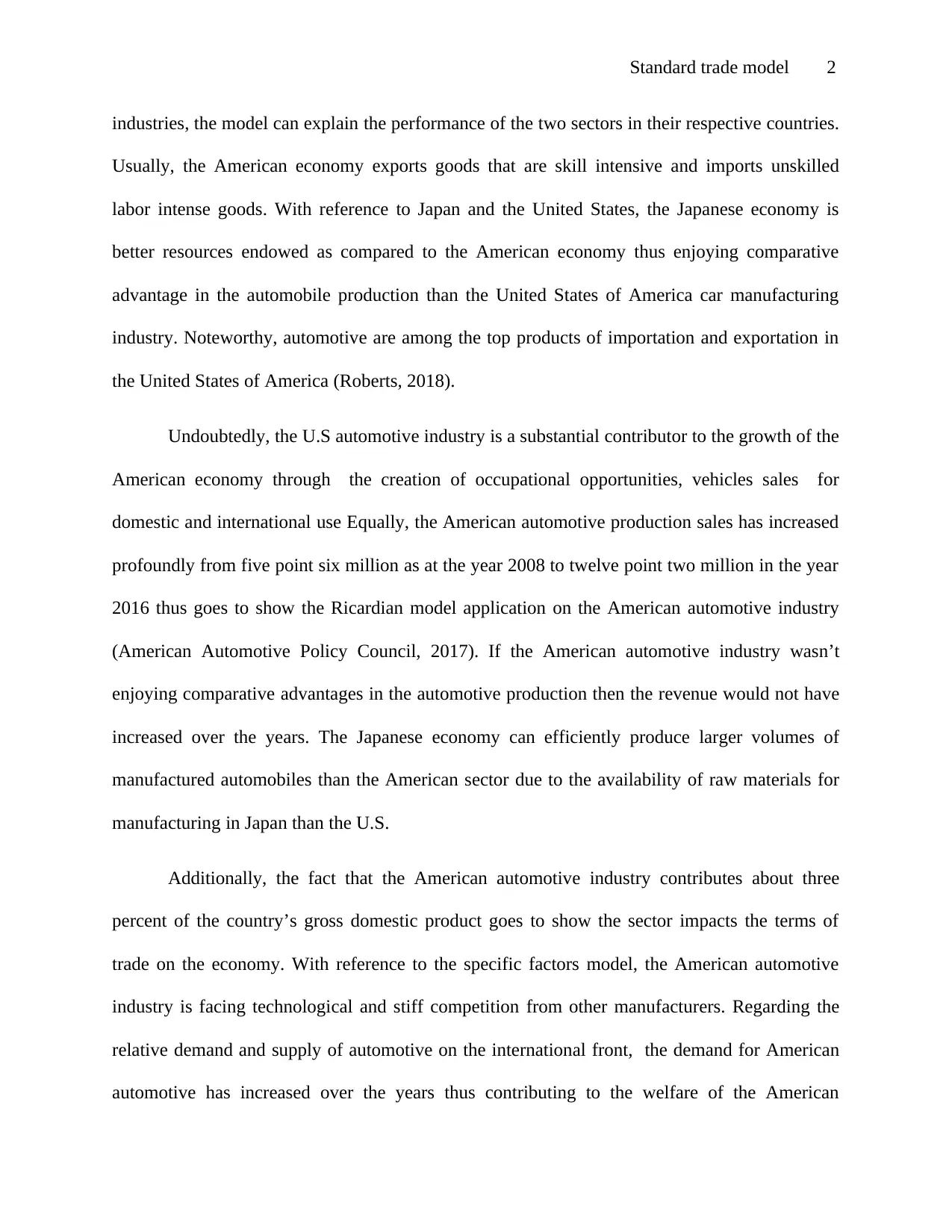
Standard trade model 2
industries, the model can explain the performance of the two sectors in their respective countries.
Usually, the American economy exports goods that are skill intensive and imports unskilled
labor intense goods. With reference to Japan and the United States, the Japanese economy is
better resources endowed as compared to the American economy thus enjoying comparative
advantage in the automobile production than the United States of America car manufacturing
industry. Noteworthy, automotive are among the top products of importation and exportation in
the United States of America (Roberts, 2018).
Undoubtedly, the U.S automotive industry is a substantial contributor to the growth of the
American economy through the creation of occupational opportunities, vehicles sales for
domestic and international use Equally, the American automotive production sales has increased
profoundly from five point six million as at the year 2008 to twelve point two million in the year
2016 thus goes to show the Ricardian model application on the American automotive industry
(American Automotive Policy Council, 2017). If the American automotive industry wasn’t
enjoying comparative advantages in the automotive production then the revenue would not have
increased over the years. The Japanese economy can efficiently produce larger volumes of
manufactured automobiles than the American sector due to the availability of raw materials for
manufacturing in Japan than the U.S.
Additionally, the fact that the American automotive industry contributes about three
percent of the country’s gross domestic product goes to show the sector impacts the terms of
trade on the economy. With reference to the specific factors model, the American automotive
industry is facing technological and stiff competition from other manufacturers. Regarding the
relative demand and supply of automotive on the international front, the demand for American
automotive has increased over the years thus contributing to the welfare of the American
industries, the model can explain the performance of the two sectors in their respective countries.
Usually, the American economy exports goods that are skill intensive and imports unskilled
labor intense goods. With reference to Japan and the United States, the Japanese economy is
better resources endowed as compared to the American economy thus enjoying comparative
advantage in the automobile production than the United States of America car manufacturing
industry. Noteworthy, automotive are among the top products of importation and exportation in
the United States of America (Roberts, 2018).
Undoubtedly, the U.S automotive industry is a substantial contributor to the growth of the
American economy through the creation of occupational opportunities, vehicles sales for
domestic and international use Equally, the American automotive production sales has increased
profoundly from five point six million as at the year 2008 to twelve point two million in the year
2016 thus goes to show the Ricardian model application on the American automotive industry
(American Automotive Policy Council, 2017). If the American automotive industry wasn’t
enjoying comparative advantages in the automotive production then the revenue would not have
increased over the years. The Japanese economy can efficiently produce larger volumes of
manufactured automobiles than the American sector due to the availability of raw materials for
manufacturing in Japan than the U.S.
Additionally, the fact that the American automotive industry contributes about three
percent of the country’s gross domestic product goes to show the sector impacts the terms of
trade on the economy. With reference to the specific factors model, the American automotive
industry is facing technological and stiff competition from other manufacturers. Regarding the
relative demand and supply of automotive on the international front, the demand for American
automotive has increased over the years thus contributing to the welfare of the American
⊘ This is a preview!⊘
Do you want full access?
Subscribe today to unlock all pages.

Trusted by 1+ million students worldwide
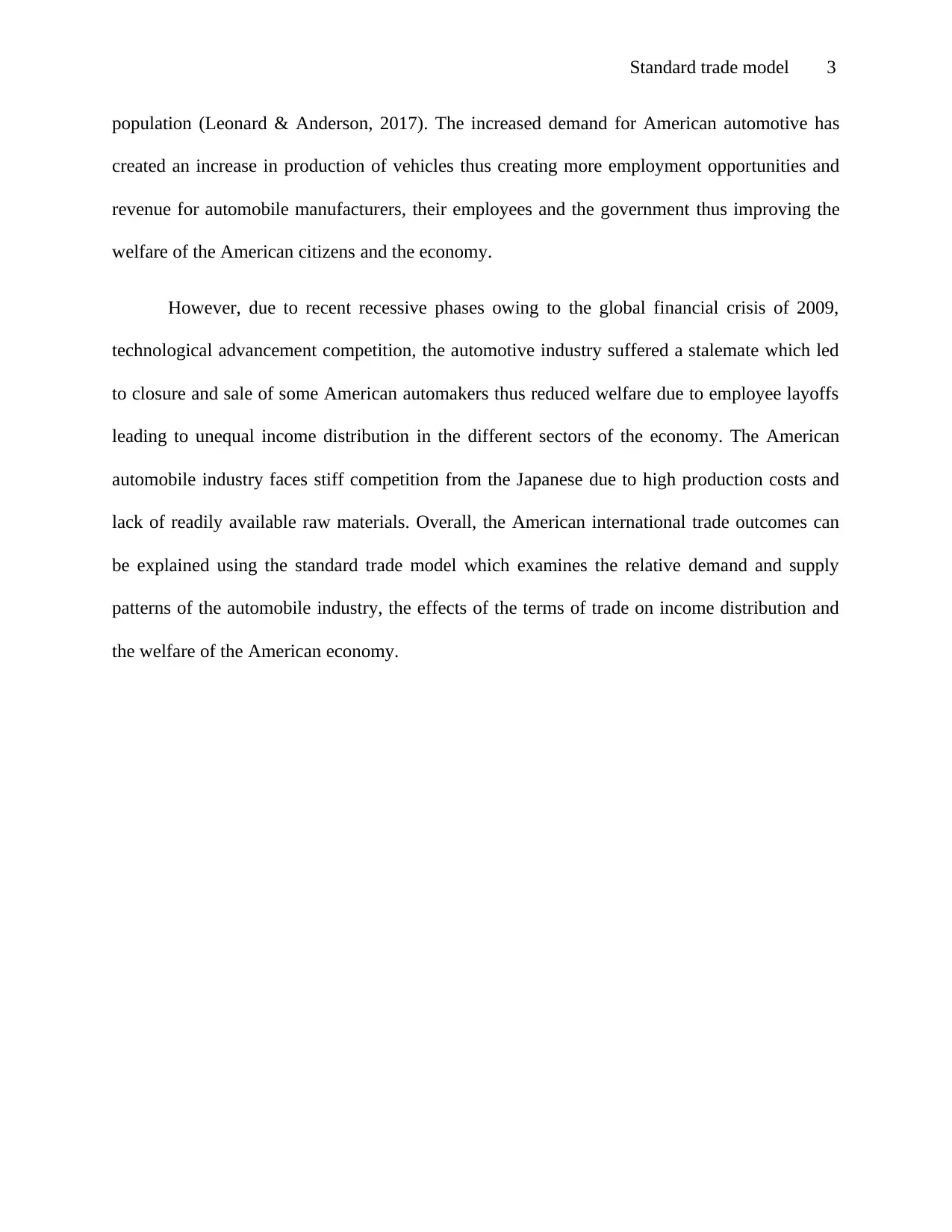
Standard trade model 3
population (Leonard & Anderson, 2017). The increased demand for American automotive has
created an increase in production of vehicles thus creating more employment opportunities and
revenue for automobile manufacturers, their employees and the government thus improving the
welfare of the American citizens and the economy.
However, due to recent recessive phases owing to the global financial crisis of 2009,
technological advancement competition, the automotive industry suffered a stalemate which led
to closure and sale of some American automakers thus reduced welfare due to employee layoffs
leading to unequal income distribution in the different sectors of the economy. The American
automobile industry faces stiff competition from the Japanese due to high production costs and
lack of readily available raw materials. Overall, the American international trade outcomes can
be explained using the standard trade model which examines the relative demand and supply
patterns of the automobile industry, the effects of the terms of trade on income distribution and
the welfare of the American economy.
population (Leonard & Anderson, 2017). The increased demand for American automotive has
created an increase in production of vehicles thus creating more employment opportunities and
revenue for automobile manufacturers, their employees and the government thus improving the
welfare of the American citizens and the economy.
However, due to recent recessive phases owing to the global financial crisis of 2009,
technological advancement competition, the automotive industry suffered a stalemate which led
to closure and sale of some American automakers thus reduced welfare due to employee layoffs
leading to unequal income distribution in the different sectors of the economy. The American
automobile industry faces stiff competition from the Japanese due to high production costs and
lack of readily available raw materials. Overall, the American international trade outcomes can
be explained using the standard trade model which examines the relative demand and supply
patterns of the automobile industry, the effects of the terms of trade on income distribution and
the welfare of the American economy.
Paraphrase This Document
Need a fresh take? Get an instant paraphrase of this document with our AI Paraphraser
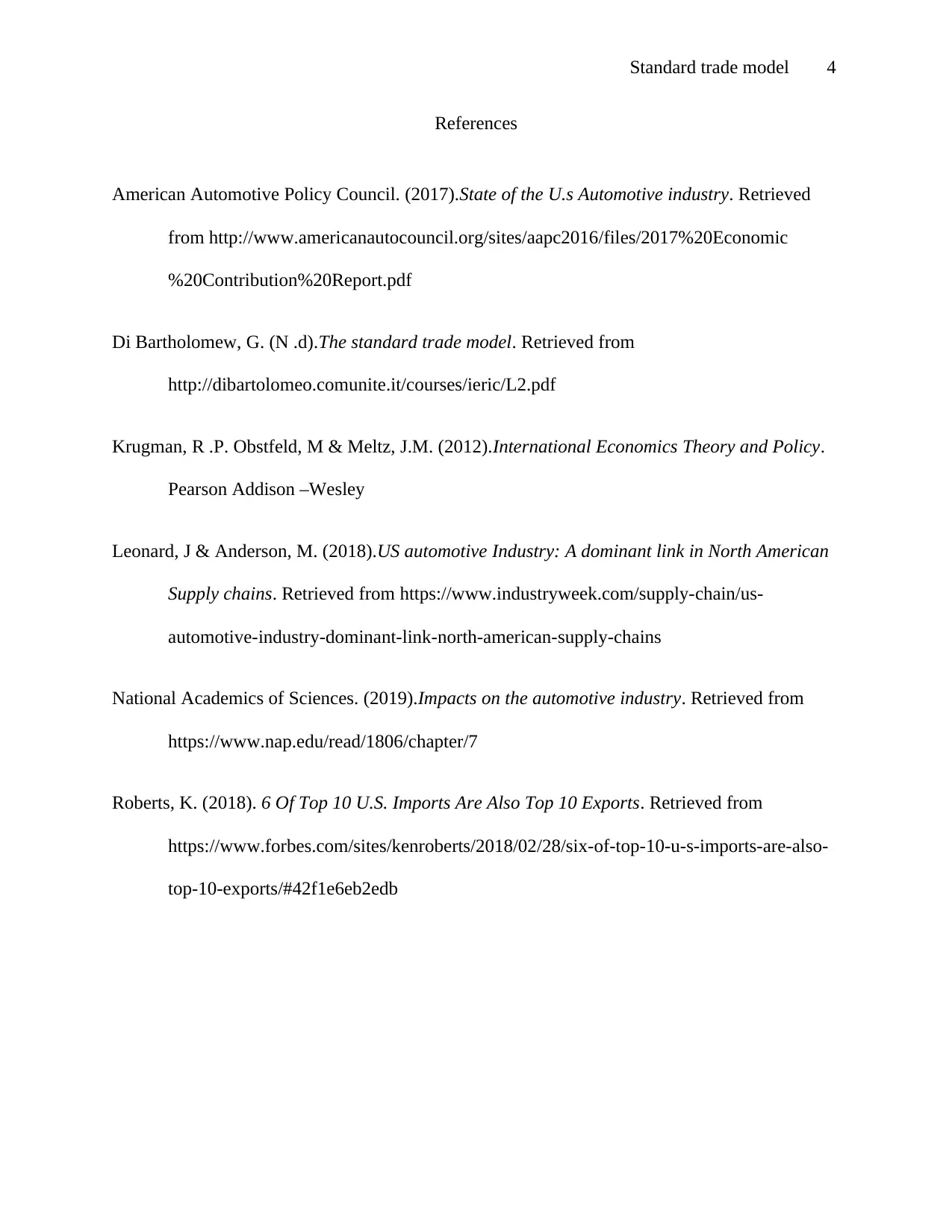
Standard trade model 4
References
American Automotive Policy Council. (2017).State of the U.s Automotive industry. Retrieved
from http://www.americanautocouncil.org/sites/aapc2016/files/2017%20Economic
%20Contribution%20Report.pdf
Di Bartholomew, G. (N .d).The standard trade model. Retrieved from
http://dibartolomeo.comunite.it/courses/ieric/L2.pdf
Krugman, R .P. Obstfeld, M & Meltz, J.M. (2012).International Economics Theory and Policy.
Pearson Addison –Wesley
Leonard, J & Anderson, M. (2018).US automotive Industry: A dominant link in North American
Supply chains. Retrieved from https://www.industryweek.com/supply-chain/us-
automotive-industry-dominant-link-north-american-supply-chains
National Academics of Sciences. (2019).Impacts on the automotive industry. Retrieved from
https://www.nap.edu/read/1806/chapter/7
Roberts, K. (2018). 6 Of Top 10 U.S. Imports Are Also Top 10 Exports. Retrieved from
https://www.forbes.com/sites/kenroberts/2018/02/28/six-of-top-10-u-s-imports-are-also-
top-10-exports/#42f1e6eb2edb
References
American Automotive Policy Council. (2017).State of the U.s Automotive industry. Retrieved
from http://www.americanautocouncil.org/sites/aapc2016/files/2017%20Economic
%20Contribution%20Report.pdf
Di Bartholomew, G. (N .d).The standard trade model. Retrieved from
http://dibartolomeo.comunite.it/courses/ieric/L2.pdf
Krugman, R .P. Obstfeld, M & Meltz, J.M. (2012).International Economics Theory and Policy.
Pearson Addison –Wesley
Leonard, J & Anderson, M. (2018).US automotive Industry: A dominant link in North American
Supply chains. Retrieved from https://www.industryweek.com/supply-chain/us-
automotive-industry-dominant-link-north-american-supply-chains
National Academics of Sciences. (2019).Impacts on the automotive industry. Retrieved from
https://www.nap.edu/read/1806/chapter/7
Roberts, K. (2018). 6 Of Top 10 U.S. Imports Are Also Top 10 Exports. Retrieved from
https://www.forbes.com/sites/kenroberts/2018/02/28/six-of-top-10-u-s-imports-are-also-
top-10-exports/#42f1e6eb2edb
1 out of 5
Related Documents
Your All-in-One AI-Powered Toolkit for Academic Success.
+13062052269
info@desklib.com
Available 24*7 on WhatsApp / Email
![[object Object]](/_next/static/media/star-bottom.7253800d.svg)
Unlock your academic potential
Copyright © 2020–2025 A2Z Services. All Rights Reserved. Developed and managed by ZUCOL.





